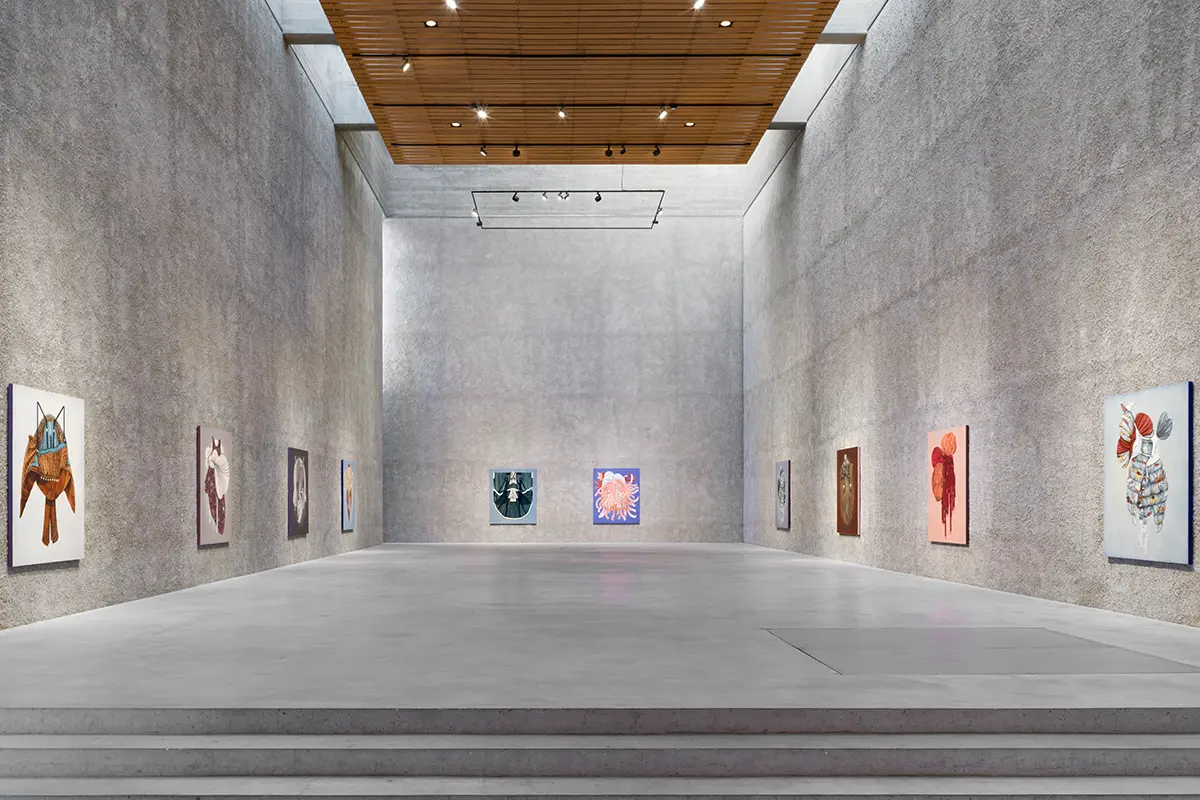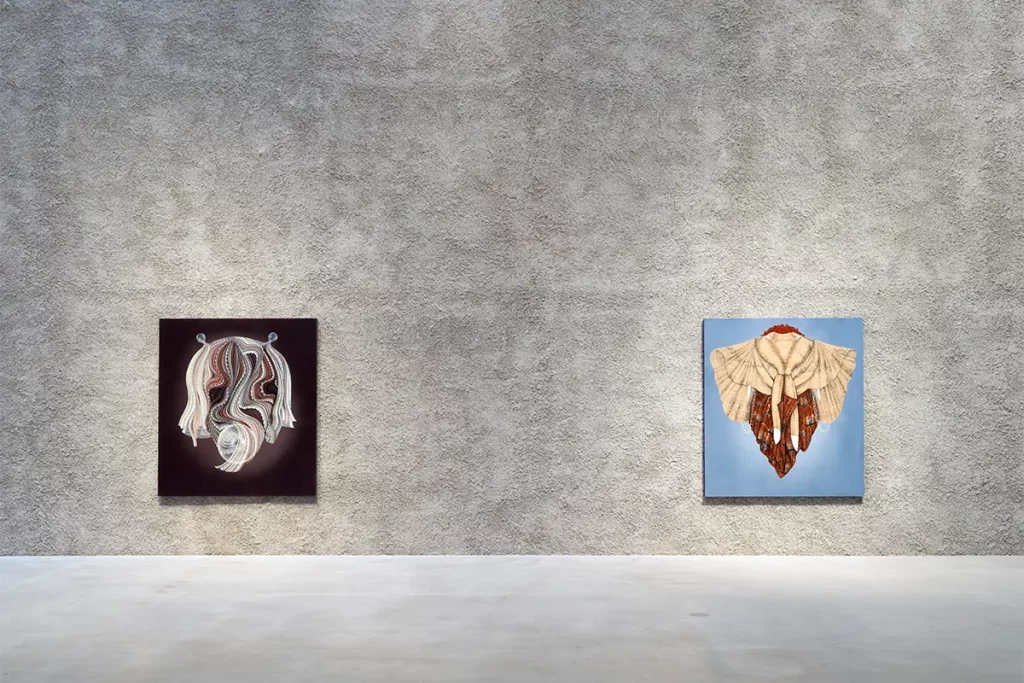König Galerie’s main program focuses on interdisciplinary, conceptual, and space-based multi-media forms including painting, printing, photography, sight, sound, and performance art
Mona Ardeleanu at König Galerie
Born in Lörrach, Germany, Mona Ardeleanu uses various types of mediums to create works that pose as a juxtaposition of familiarity meets unfamiliarity. Now residing in Stuttgart, Germany where she both lives and works after she studied under Alexander Roob, Frank Ackermann, and Daniel Richter to name a few at the Staatlichen Akademie der Bildenden Künste in Stuttgart, Karlsruhe, Vienna, and Munich.
With a background in building her imagery with a sculptural approach, work is done on creating natural layers within one piece, bringing depth to the painting in ways that take more than one viewing to comprehend.
Polymorph: a two-dimensional finish
Ardeleanu is now holding an exhibition of her latest series titled Polymorph, the largest solo collection she has curated to date within the walls of the König Galerie in Berlin. Ardeleanu had created large canvases brushed with oil, all tailing the same dimensions, displayed vertically and completed with a silky varnish that upholds the glossy exterior, creating a two-dimensional finish giving the raw eye a guessing game of what is used.
Ardeleanu’s artworks are also part of the collection of the State of Baden-Württemberg, the Stuttgart Art Museum, the Marta Herford Collection, and the Würth Collection. As this is not her first time with König Galerie, she had two previous exhibitions, one in Berlin in 2020, and one in London in 2022.
With a range of textures, patterns, colors, shapes, and visions that are first sketched raw with no stencil needed, she builds up through her process of adding steps on each part of the journey to create a finished piece.
The motivation behind the movement
«As a kid, I always loved painting and drawing. There was a rule in my school lessons where I was not allowed to take any pencils, except for when I needed to write something down because I was drawing all the time and the teachers didn’t seem to like that so much. By the time I turned sixteen I had fatigue fractions on both of my wrists due to competitive sports that I had taken up throughout my childhood and teenage years. This is what made me realize that I needed full function in both of my hands for my future if I wanted to continue with a career in painting. It was clear to me that I needed to make a change».
Polymorph: canvases of real-life optical illusions
«I never thought about how to differentiate my style of art compared to other artists. I always think of the fewer and playing and working on the impact of familiarity and it is essential within my work and my research before starting a new project or a new work of art. I’m questioning technical habits and researching and searching for resemblance which plays a minor role in my work. A feature of my paintings is that the painted objects themselves are all connected within their appearance to their real life, making them free of templates. I never paint something to copy or show reality in a painted way, I paint for the needs of each painting. To realize this freedom and to give the possibility of creating things that seem endless».
Her latest exhibition, Polymorph showcases canvases of real-life optical illusions and they seem to almost morph into a reality. With life-like titles to her paintings such as Shelly, Malva, Abul, and Bruno, a human edge is brought to life on paper, almost as if every piece has a personality. Drawn free-handed, there is no need for stencils in Ardeleanu’s work. Therefore it could not be a match for the vision she wishes to draw.
Life-like features combated with functional details. Pop colors are muted down the warm tones. Shadows are sketched, and the lighting is low, but the energy is high, depicting the personality, mood, and ambiance on each canvas.
Jonathan, Bruno and Glossata: the faces of Polymorph
Jonathan: A shy-looking soul painted in tones of light blue, navy, charcoal, and ivory. With the shadow reflecting the body, it seems as if Jonathan is illuminated by the light from above. Its placement of feathers flocking from the body seems as if he is growing into a new soul, a more comfortable one – to take a breath and show the universe who Jonathan really is.
Bruno: Arms crossed? But they’re not really arms. A light brown, almost stuffed scarf-like creature molds itself to a rounded circle, making it look content yet concerned, sad yet steady. Its claws bring contrast and confuse the mind into thinking its kind, but the matching ring belt-looking eyes translate the style and conscious choices on this brown furry body. Is it a scarf? A blanket? It’s up to the audience to decide.
Glossata: A strong structure to the untrained eye, a soft one for the trained. Tentacles like arms and a full body silhouette bring an elegance over the draped fabric. A two-dimensional body seems brought to life with attention to detail, such as the letterings written throughout the middle of the canvas.
Mona Ardeleanu: people should observe art from their own point of view
«Each painting owns its own narrative. It’s not the artist that owns the work of art but it’s the actual art that owns itself. As I work associatively, there is a different story behind each of them, but I don’t feel like I own it. The background stories of my work are not shared with the public, they are kept to myself because I feel as if people should observe art from their own point of view».
Ardeleanu’s canvases take on a life of their own with human-like, fictional features of layers of fictional hair, shapes and objects of eyes that are anything but eyes, and silhouettes sketched from time-sifted shapes creating life-like molds fit for the raw eye to keep wondering about.
Does art imitate life, or does life imitate art?
«I’m learning through seeing my world – for me, inspiration is connecting to nature, art, craftsmanship, my kids, design, fashion, history, etc. When I can feel the complexity in someone’s work, it makes me feel like a fan, but I’m not influenced by them».
The real owner of art is the consumer – the mind, body, and soul of the body registering the expression and creating their own story based off of their instinct, therefore making every piece as relevant as the last.
König Galerie
Founded by Johann König in Berlin in 2002, and is now run by Lena and Johann König alongside Laura Attanasio. The gallery currently represents over forty internationally known, emerging and established artists. Thus, König Galerie’s main program focuses on interdisciplinary, conceptual, and space-based multi-media forms including painting, printing, photography, sight, sound, and performance art.




















